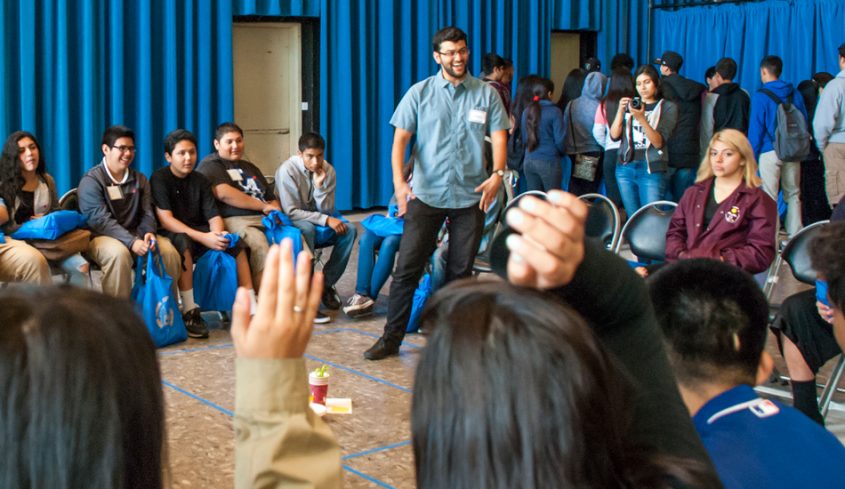Learning Life Lessons About Urban Planning Hundreds of L.A. high school students discover meaning of social inequality in city planning during Luskin’s Youth Empowerment Conference.
By Breanna Ramos
Sometimes, lessons are learned the hard way. That was especially true for some Los Angeles high school students who recently came to UCLA to learn about city planning.
“It wasn’t fair,” high school sophomore Ashley Flores said after participating in an exercise designed to teach teenagers that life — and urban planning — aren’t always equitable.
Planners of Color for Social Equity (PCSE), a graduate student organization housed in UCLA Luskin’s Department of Urban Planning, recently hosted more than 200 high school students from the East Los Angeles Renaissance Academy’s (ELARA) School of Urban Planning and Design at the 4th Annual Urban Planning Youth Empowerment Conference (UPYEC) held in Ackerman Ballroom on the UCLA campus.
A day of urban planning workshops and activities, UPYEC provides high school students with opportunities to learn lessons about education and life.
“My goal is for the students to gain exposure to college campuses, as it increases the likelihood that they will attend higher education,” ELARA principal Jose Gonzalez said. “But this is also about introducing students to what urban planning is, so connecting them with graduate students that are soon to be professionals in the field is important.”
Every high school student participated in an exercise called Spatial Justice. Students were divided into groups and assigned spaces in which to build their own “city.” What the participants didn’t know was that conference organizers had distributed building materials inequitably, presenting obstacles that mirror real-life city planning.
“We didn’t have control over our own city,” Flores said. “They kept taking our stuff away, and we couldn’t argue without having to go to jail.”
Luskin’s Urban Planning students volunteered to facilitate the workshop, role-playing as city hall administrators who regulate the building development process.
“We’re trying to show the students that if you’re connected and have money, you get additional resources, are treated better and your city looks better,” Urban Planning student Kate Traynor said. “This allows us to teach them about social inequality and how that has an impact on the way that our cities are built.”
While the spatial justice workshop was intended to educate students about how planning presents obstacles, it was also intended to encourage students to use planning as a tool to undo these injustices. This was the intent of the discussion portion of the workshop, Luskin students said.
“What if resources were distributed equitably in the real world?” Luskin student and conference organizer Julia Heidelman said of the goals of the workshop. “And what if people from under-resourced communities could decide how they were redistributed? Why and how can planning work to undo these systems?”
In addition to Spatial Justice, the students attended workshops on active transportation, community organizing, food access, urban design, the urban forest and mapping of transit routes.
One of PCSE’s goals for the conference is to diversify the field of urban planning. In 2012, PCSE learned that ELARA was located in East Los Angeles and is one of only three schools nationally with an urban planning program, making it a great fit for the organization’s community outreach goals.
“I can’t wait until someone comes to apply to our school and says, ‘I went to the Youth Conference,’” said Leo Estrada, professor of Urban Planning at Luskin and a speaker at the event. “It should happen next year for the first group that we ever talked to, and the years following, and it is my hope that we always have someone apply because of their experience here.”
PCSE received funding from the Grad Student Association Sustainability Resource Center, the Healthy Campus Initiative, the Campus Programs Committee Youth Fund from the SOLE office, the Grad Student Association Discretionary Fund, the campus Event Fund, and through a Diversity Development Grant from the Luskin D3 (Diversity, Disparities and Difference) Initiative.




Leave a Reply
Want to join the discussion?Feel free to contribute!